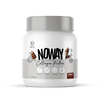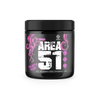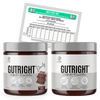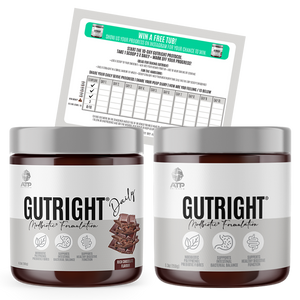Sweeteners Whispering Sweet Little Lies…

Sweeteners, are we going there? An undoubtedly large can of worms but hey, ‘question everything’ right?! We took a look at a recent industry analysis of many pre-workout formulas and were shocked to find the amount that used Artificial Sweeteners in their products:
Why are we talking about this?
They are everywhere, zero-calorie sweeteners, nutritive, non-nutritive, and artificial sweeteners, they roll off the tongue nowadays without a second thought because they are quite literally everywhere! We moved from naturally occurring sugars by the bucket load to these alternatives that yield far less if not zero calories, unlike their sugary competitor. But not all sweeteners are created equally…
Sweeteners categorized into 6 groups:
- Sugars.
- Sugar Alcohols.
- Natural Caloric Sweeteners.
- Natural Zero Calories Sweeteners.
- Modified Sugars.
- Artificial Sweeteners.
Here is the list of commonly sweeteners in alphabetical order to make it easy to find the ones you use or have seen or use.
- Acesulfame K – E950 Artificial Sweetener.
- Agave Syrup – Modified Sugar.
- Aspartame – E951 Artificial Sweetener.
- Aspartame-Acesulfame Salt – E962 Artifical Sweetener.
- Barley Malt Syrup – Modified Sugar.
- Blackstrap Molasses – Sugar extract.
- Brown Rice syrup – Modified Sugar.
- Cane Juice – Sugar extract.
- Coconut Palm Sugar – Sugar Extract.
- Corn Sugar HFCS – Modified sugar.
- Dextrose – Sugar
- Erythritol – Sugar Alcohol (E968)
- Fructose – Sugar.
- Galactose – Sugar.
- Honey – Natural Sugar.
- Isomalt – Sugar Alcohol E953
- Lactitol – Sugar Alcohol E966
- Lactose – Sugar.
- Maltitol – Sugar Alcohol E965.
- Maltodextrin – Sugar.
- Maltose – Sugar.
- Mannitol – Sugar Alcohol E421.
- Maple Syrup – Sugar Extract.
- Monk Fruit – Natural Sweetener.
- Palm Sugar – Sugar Extract.
- Polydextrose – Sugar Fibre.
- Saccharin – Artificial Sweetener E954
- Saccharose (sucrose) – Sugar.
- Sorbitol – Alcohol Sugar E420
- Stevia – Natural Sweetener.
- Sucralose – Artificial Sweetener E955
- Sucrose – Sugar.
- Xylitol – Sugar Alcohol E967.
That’s a lot to take in right, and that’s not even half the list that’s out there as additives… yeesh!
However, today we are focusing on some of the most common forms of sweeteners that have possibly the worst rap sheet and yet, are the most popular:
-
Sucralose – Artificial Sweetener, Acesulfame K, or Ace-K for short.
Why? Because when we were developing products and looking for ‘low calorie’ sweeteners, these suckers were thrown at us as options left to right and center for a few reasons; they are cheap, synthetic, and predictable.
Non-Nutritive sweeteners used in foods and drinks are used as an inert additive that’s considered a low to no impact on the glycaemic index – however, further research is starting to suggest otherwise on these once believed to be nil effect, satisfying additives. Non-Nutritive sweeteners are beginning to show links and increased risk factors with Metabolic Syndrome and this is reflected across physiological, biochemical, clinical, and metabolic factors that contribute to:
- Increased risk of cardiovascular disease [1]
- Type 2 diabetes [1]
- Hypertension [2]
- Glucose intolerance [2]
- Proinflammatory states [2]
- Atherogenic dyslipidemia [2]
- Kidney disease [3]
This goes against the initial narrative; that they were an alternative for those with insulin concerns, they could opt for these as they were believed to help lower these correlations initially pegged to sugar… The ones listed above are considered “High intensity” Sweeteners by the FDA and are also banned in many countries around the world because of their links with hazardous effects. They can be received by sweet receptors at up to 700x sweeter than sugar! Yikes!
But they are Non-Nutritive sweeteners, how is it they have such an impact?
“Despite FDA approval of several sucrose alternatives marked as Generally Recognized as ‘Safe’ (GRAS), there remains growing concern about the potentially harmful side effects associated with NNS consumption. Although several epidemiologic studies are focusing on artificial sweetener use and weight gain, it is critical that when interpreting such studies, we consider factors that affect causality, and control for confounding factors such as age, diet, and environment, as well as additional stressors that may modify microbiota composition.” – [4,5]
Ah-ha! Like we always say… everything begins in the gut. We sound like a bunch of repetitive nags we know, but hey when you know something you have to share it right? That’s the beauty of knowledge and its power!
In previous knowledge and what still stands currently is that metabolic disorders that include the symptoms of above come from high intake of sugar, upregulating hepatic uptake and metabolism of fructose, which leads to fatty accumulation in the liver, dyslipidemia and you guessed it… decreased insulin sensitivity. I hear you say, ‘but that’s sugar?!’ that’s obvious. Here is the catch, if you take something that is measured as 700x the sweetness of sugar (sucrose) how do you think your body understands that? Non-nutritive sweeteners still impact the sweet taste receptors, gut microbiota composition, and learned habitual responses from the general intake of ‘sweetness’.
How one person responds is different from the next
Now we are looking at the microbiome here and in the next section – an internal population with at least 10x fold variable differentiation from sally to Joe blogs. So, while one person can consume Non-Nutritive sweeteners and have no issues, others may not respond in the same way. We must always take this into account when looking at an individual’s response to certain dietary aspects.
Non-Nutritive/artificial sweeteners still interact with the family of sweet taste receptors called ‘T1R’ through a G-protein called ‘α-Gustducin’ which is a protein associated with the taste and gustatory system. This particular protein plays a role in the recognizing of bitter, sweet, and umami taste stimuli. It also increases intracellular cAMP which is involved in the regulation of glycogen, sugar, and lipid (fat) metabolism. This stimulation then leads to the assumption from here that this may be the core signaling issue that defeats the prior logic of physical sugar contributing to metabolic disorders and not Artificial sweeteners when this receptor is still impacted [6]
Sweet taste receptors in the gut
Sweet taste receptors have been found not just on the tongue, but throughout the GI Tract, the Biliary Tract, and interestingly the Respiratory Tract – leading to suggest that perhaps sweetness end those in particular of Non-Nutritive sweeteners, once thought to have nil effect, may at up to 700x the sweetness of sugar, indeed have not-so-inert effects.
Introducing the Enteroendocrine… the endocrine cells of the intestinal tract. Sweet taste receptors are found in both the L and K enteroendocrine cells which secrete hormones such as:
- Somatostatin.
- Motilin.
- Cholecystokinin.
- Neurotensin.
- Vasoactive intestinal peptide.
- Enteroglucagon
While these have no relevance right now, they will later in future articles; so, it’s good to familiarise yourself with their names. Sweet taste receptors were also located on the B-Islet cells of the pancreas [11]. Ligand binding is where a substance forms a complex with a molecule to serve a biological purpose in the body, on receptors of the enteroendocrine cells affecting their hormone secretion in the body. Activation of these sweet receptors from enteroendocrine cells, which make up approximately 90% of the intestinal epithelial cells can act locally on their own accord from stimulation to alter hormone secretion [12].
Non-Nutritive Sweeteners
Non-nutritive sweeteners such as Ace-K and Sucralose both upregulate sodium-glucose co-transporter 1 (SGLT-1), to non-nerdify this, this is upregulated to allow glucose (sugar) to cross the small intestinal membrane barrier and is an active glucose transporter, from there moved then into circulation through Glucose transporter-2 (GlUT2). If we lost you, essentially these sweeteners still stimulate these mechanisms that are activated when carbohydrate/sugar ingestion is signaled… even though you have no actual sugar available in the small intestine.
SGLT-1 also signals Glucagon like-peptide 1 which signals insulin release to allow the carry of glucose into cells, however, this is not happening because there is no physical glucose to transport into the cells. From here it is hypothesized this creates an insulin resistant/metabolic disorder profile [13,14]. Essentially, it is believed that it is now possible for Non-nutritive sweeteners such as Sucralose and Ace-K through their noticeable ability to stimulate sweet taste receptors on the enteroendocrine cells of the intestinal tract, to therefore alter the release of hormones involved in glucose balance.
Sweet little lies from the gut bugs
Its one big harmony of bacteria, viruses, and fungi inside and outside of us – millions of the critters and their populations are established from our birth up until our death. We rarely pay homage to their existence, when in reality our existence depends on theirs and vice versa, kind of weird when you think of it that way hey… (staring blankly into space wondering if we are indeed just a bus for bugs).
Aberrations of the gut microbiota diversity have been affiliated with the development of type 2 diabetes also, so we are seeing more of a link in painting this whole picture here [18]. Again, another series of words you have heard us talk about for years now – Bacteroidetes and Firmicutes, mostly because Matt says the first word with such a high pitch voice for the differential effect it sticks in your brain.
Bacteria Phyla Grouping
The two main bacterial phyla of the human microbiome and varying ratios of the population have been observed in obese and lean individuals to establish the effect that they can have on our composition where firmicutes were significantly higher than that of Bacteroidetes in obese subjects. Obesity is a component of ‘Metabolic Syndrome’ and non-nutritive sweeteners have been shown to increase population firmicutes and also Lactobacilli SPP [20]. The ratio of these two phyla after consumption of non-nutritive sweeteners greatly represented that of an obese subject’s phyla establishment [20].
Deadbug signaling...
From here these ratios of decreasing bifidobacterial and increase of enterobacteria leads to endotoxemia – and as such, dead bacteria release lipopolysaccharides which are inflammatory endotoxins that create an environment of low-grade inflammation, causing chronic cortisol signaling to try and mediate this stress response from inflammation. Cortisol’s job is to mediate stress for the purpose of survival and will inhibit insulin production, thus, preventing insulin sensitization of cells, insulin resistance, obesity, and type 2 diabetes [20]. There is also another level which is probably another blog In and of itself, through microRNA which is Gene expression of microbes… it's juicy. Essentially, these genes can be altered in their expression, stress, diet, and exercise, and non-nutritive sweeteners also affect here too [21].
Right, you have made it this far… now what? What about natural alternatives?
To wrap all of this up, do the naturally derived sweeteners still have an effect? Interestingly, when they studied the metabolism of nutritive sweeteners, like that of Stevia it appeared to have no effect on dysbiosis of the flora of the human microbiome and rather, that it actually was metabolized by the good guys – Bacteroides. This was tested on cultures of Coliforms, Bifidobacteria, Enterococci, and Bacteroides, and, Bacteroides were the only intestinal group that was able to hydrolyze [22] (the breakdown of chemical bonds with water molecules) Stevioside and Rebaudioside, which are the metabolites of Stevia, all while having no impact on other flora groups, unlike their artificial counterparts as we have now learned.
Stevia Is also shown to have zero carcinogenic effects whereas Ace-K contains the carcinogenic compound - Methylene Chloride/dichloromethane also the main component in paint stripper, degreasers and varnish removal products… sounds, umm, delightful…
Alcohol Sugars?
Most alcohol sugars are absorbed in the small intestine without an impact on the flora populations of the microbiome. However, some polyols/alcohol sugars can reach the large intestine and increase the numbers of bifidobacterial populations , these polyols are –
- Isomalt.
- Maltitol.
- Lactitol.
- Xylitol.
This species of bacteria has been linked in with Vitamin B production, use of insoluble carbohydrates, the liberation of polyphenols, maturation of immune system, blocking adhesion of pathogens to the intestinal mucosa and production of organic acids acetate and lactate from the fermentation of carbohydrates. These can then be converted to butyrate by other colon bacteria for the use in metabolism and insulin response among other integral responsibilities [24,25]. However, this species is very fermentation dominant in function, so you may notice that combining these additives with complex carbohydrates may lead to some intense intestinal discomfort or the classic green apple splatters… use sparingly.
Take home message
Well, the main message to take home here is – read your labels and know your numbers and codes. Your gut will thank you for it. However, the other aspect here to take into account is that we can see how diverse people’s responses to these types of additives can be, for one person depending on their flora composition, they may have little to no effect from them, whereas the next person may have a more dramatic response. This of course comes back to, everyone is individual but if you can make a more educated decision on what you are putting in your regime and diet, then that is what is important. Being told that zero-calorie additives yield no response when science is at the forefront of the microbiome and what modifies its ratios, discovering that minute amounts of these additives still yield some response is fascinating. Read your labels, decipher the codes, and do your research it will pay dividends on your health.
References
- A comprehensive review on metabolic syndrome.Kaur J Cardiol Res Pract. 2014; 2014():943162.
- Diagnosis and management of the metabolic syndrome: an American Heart Association/National Heart, Lung, and Blood Institute Scientific Statement. Grundy SM, Cleeman JI, American Heart Association., National Heart, Lung, and Blood Institute. Circulation. 2005 Oct 25; 112(17):2735-52.
- Patterns of Beverages Consumed and Risk of Incident Kidney Disease. Rebholz CM, Young BA, Katz R, Tucker KL, Carithers TC, Norwood AF, Correa A Clin J Am Soc Nephrol. 2019 Jan 7; 14(1):49-56.
- https://www.ncbi.nlm.nih.gov/pmc/articles/PMC6471792/#B21-nutrients-11-00644
- Gut reaction: environmental effects on the human microbiota. Phillips ML Environ Health Perspect. 2009 May; 117(5):A198-205.
- Metabolic effects of non-nutritive sweeteners. Pepino MY Physiol Behav. 2015 Dec 1; 152(Pt B):450-5.
- Non-nutritive sweeteners and their role in the gastrointestinal tract. Brown RJ, Rother KI J Clin Endocrinol Metab. 2012 Aug; 97(8):2597-605.
- T1R3 and gustducin in gut sense sugars to regulate expression of Na+-glucose cotransporter 1. Margolskee RF, Dyer J, Kokrashvili Z, Salmon KS, Ilegems E, Daly K, Maillet EL, Ninomiya Y, Mosinger B, Shirazi-Beechey SP Proc Natl Acad Sci U S A. 2007 Sep 18; 104(38):15075-80.
- The role of the gut sweet taste receptor in regulating GLP-1, PYY, and CCK release in humans. Gerspach AC, Steinert RE, Schönenberger L, Graber-Maier A, Beglinger C Am J Physiol Endocrinol Metab. 2011 Aug; 301(2):E317-25
- Sweet taste receptor expressed in pancreatic beta-cells activates the calcium and cyclic AMP signaling systems and stimulates insulin secretion. Nakagawa Y, Nagasawa M, Yamada S, Hara A, Mogami H, Nikolaev VO, Lohse MJ, Shigemura N, Ninomiya Y, Kojima I PLoS One. 2009; 4(4):e5106.
- Non-nutritive sweeteners and their role in the gastrointestinal tract. Brown RJ, Rother KI J Clin Endocrinol Metab. 2012 Aug; 97(8):2597-605.
- Gut microbiota, enteroendocrine functions and metabolism. Cani PD, Everard A, Duparc TCurr Opin Pharmacol. 2013 Dec; 13(6):935-40.
- Artificial sweeteners: a systematic review of metabolic effects in youth. Brown RJ, de Banate MA, Rother KI Int J Pediatr Obes. 2010 Aug; 5(4):305-12.
- Ghrelin, CCK, GLP-1, and PYY(3-36): Secretory Controls and Physiological Roles in Eating and Glycemia in Health, Obesity, and After RYGB. Steinert RE, Feinle-Bisset C, Asarian L, Horowitz M, Beglinger C, Geary N Physiol Rev. 2017 Jan; 97(1):411-463.
- Taste cells of the gut and gastrointestinal chemosensation. Egan JM, Margolskee RFMol Interv. 2008 Apr; 8(2):78-81.
- Non-nutritive sweeteners and obesity. Fernstrom JD Annu Rev Food Sci Technol. 2015; 6():119-36.
- Gut microbiota in human adults with type 2 diabetes differs from non-diabetic adults. Larsen N, Vogensen FK, van den Berg FW, Nielsen DS, Andreasen AS, Pedersen BK, Al-Soud WA, Sørensen SJ, Hansen LH, Jakobsen M
- The Gut Microbiome Profile in Obesity: A Systematic Review. Castaner O, Goday A, Park YM, Lee SH, Magkos F, Shiow STE, Schröder H Int J Endocrinol. 2018; 2018():4095789.
- Artificial sweeteners induce glucose intolerance by altering the gut microbiota. Suez J, Korem T, Zeevi D, Zilberman-Schapira G, Thaiss CA, Maza O, Israeli D, Zmora N, Gilad S, Weinberger A, Kuperman Y, Harmelin A, Kolodkin-Gal I, Shapiro H, Halpern Z, Segal E, Elinav E Nature. 2014 Oct 9; 514(7521):181-6.
- Metabolic endotoxemia initiates obesity and insulin resistance. Cani PD, Amar J, Iglesias MA, Poggi M, Knauf C, Bastelica D, Neyrinck AM, Fava F, Tuohy KM, Chabo C, Waget A, Delmée E, Cousin B, Sulpice T, Chamontin B, Ferrières J, Tanti JF, Gibson GR, Casteilla L, Delzenne NM, Alessi MC, Burcelin R Diabetes. 2007 Jul; 56(7):1761-72.
- MicroRNAs in the pathogenesis of type 2 diabetes: new research progress and future direction.Miao C, Zhang G, Xie Z, Chang J Can J Physiol Pharmacol. 2018 Feb; 96(2):103-112.
- Metabolism of Stevioside and Rebaudioside A from Stevia rebaudiana Extracts by Human Microflora CLAUDIO GARDANA, † PAOLO SIMONETTI,*,† ENRICA CANZI, ‡ RAFFAELLA ZANCHI, ‡ AND PIERGIORGIO PIETTA. J. Agric. Food Chem. 2003, 51, 6618−6622
- Effects of Sweeteners on the Gut Microbiota: A Review of Experimental Studies and Clinical Trials. Francisco Javier Ruiz-Ojeda,1,2,4Julio Plaza-Díaz, Adv Nutr. 2019 Jan; 10(Suppl 1): S31–S48. Published online 2019 Feb 5. doi: 1093/advances/nmy037
- Bifidobacteria and Butyrate-Producing Colon Bacteria: Importance and Strategies for Their Stimulation in the Human Gut. Audrey Rivière, Marija Selak, Front Microbiol. 2016; 7: 979.Published online 2016 Jun 28. doi: 3389/fmicb.2016.00979
- What is the Healthy Gut Microbiota Composition? A Changing Ecosystem across Age, Environment, Diet, and Diseases. Emanuele Rinninella,1,2,*Pauline Raoul,2 Marco Cintoni, Microorganisms. 2019 Jan; 7(1): 14. Published online 2019 Jan 10. doi: 3390/microorganisms7010014. Karl-Bernd Hüttenbrink, Prof. Dr. med.,*,1 Thomas Hummel, Prof. Dr. med.,2 Daniela Berg, Prof. Dr. med.,.
- Dtsch Arztebl Int. 2013 Jan; 110(1-2): 1–7.Published online 2013 Jan 7. doi: 10.3238/arztebl.2013.0001








